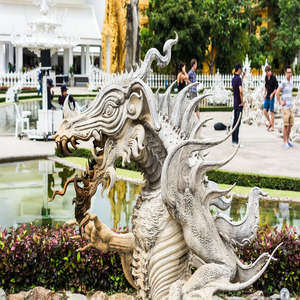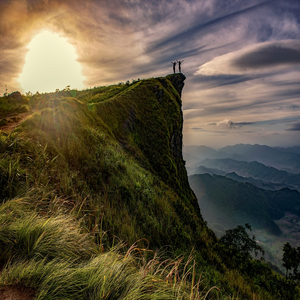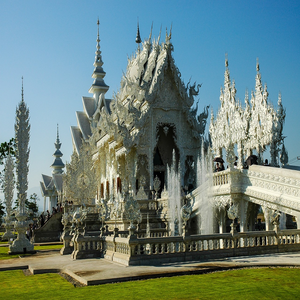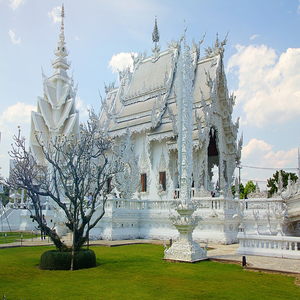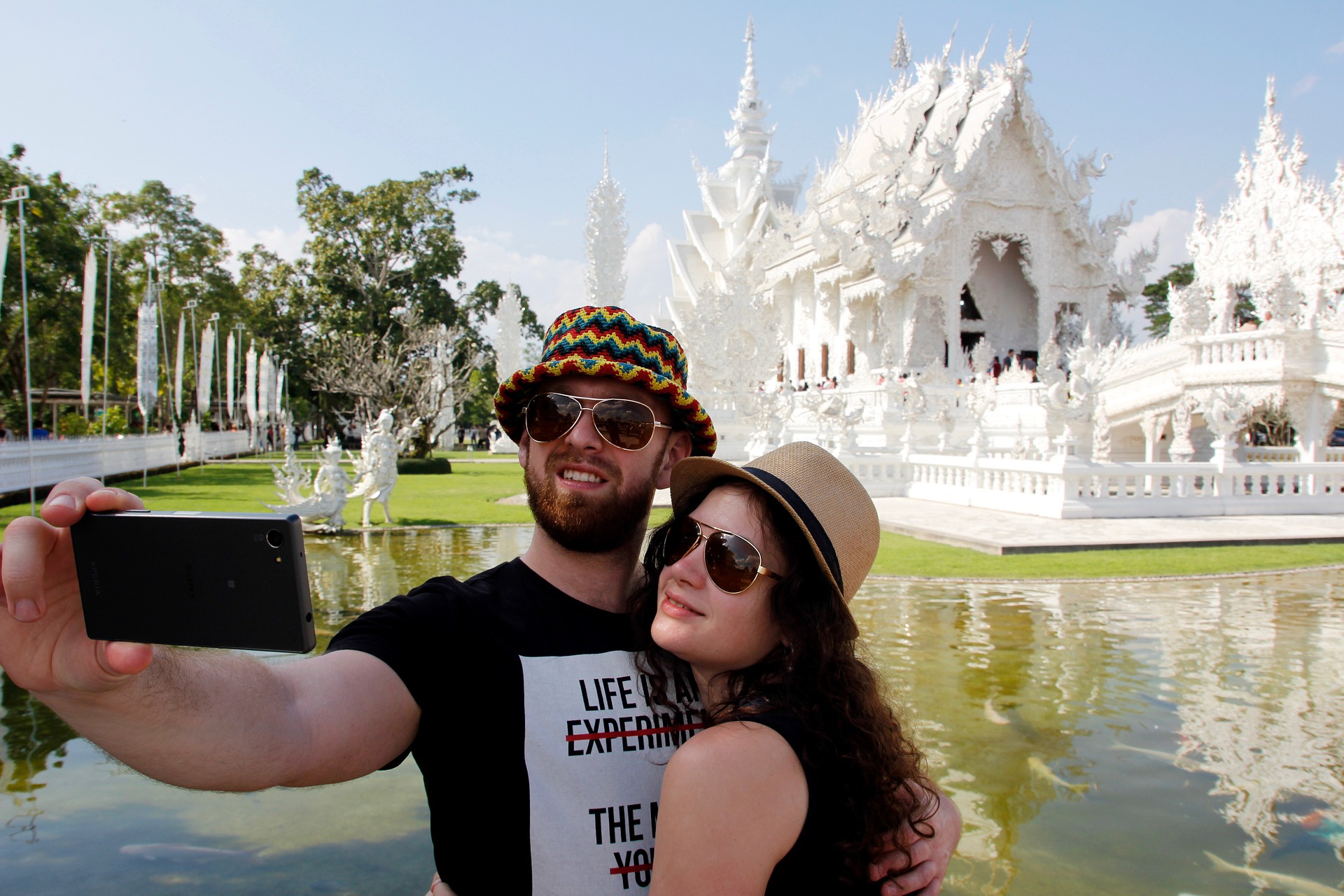
Chiang Rai Attractions
Chiang Rai is a city located in the northernmost part of Thailand. It is often overshadowed by its neighbor Chiang Mai, but it is a hidden gem of Thailand that is worth exploring. Chiang Rai is a melting pot of cultural diversity that has been shaped by its history and geography. Here are some inspiring travel guide about Chiang Rai.
1. Visit the White Temple - Wat Rong Khun: This stunning temple is a must-visit attraction in Chiang Rai. It was designed by Chalermchai Kositpipat, a Thai artist, and it is a unique blend of traditional Thai and contemporary art. The temple’s all-white exterior is covered in intricate carvings and hand-painted murals that tell the story of Buddhism.
2. Explore the Golden Triangle: This is a region where the borders of Thailand, Laos, and Myanmar meet. It is a historically significant area that was once known for opium production. You can take a boat ride on the Mekong River and witness the border between Thailand and Laos, visit the Hall of Opium Museum, and explore the local markets.
3. Hike to the top of Doi Tung: This mountain is the perfect spot for nature lovers. It offers a challenging but rewarding hike to the top, where you can enjoy panoramic views of the surrounding countryside. At the summit is a mountaintop temple, Wat Phra That Doi Tung, where you can meditate and take in the peacefulness of the mountains.
4. Visit the Hill Tribes: The hill tribes of Chiang Rai are a fascinating cultural group to explore. They live in remote villages in the mountains and have their own unique customs and traditions. You can visit the villages and interact with the locals, learn about their daily lives, and even try some of their local delicacies.
5. Try local food: Chiang Rai is famous for its delicious food, and there are numerous street vendors, night markets, and restaurants where you can try local dishes like Khao Soi, a Northern Thai curry noodle soup, and Sai Oua, a spicy pork sausage.
Chiang Rai is a destination that combines natural beauty, rich culture, and a fascinating history. It is a magical place where you can immerse yourself in the local way of life and discover the hidden treasures of Thailand.

0$
0$
3000$

Price From
$103.10
Doi Mae Salong and Mae Sai are essentials when in need to explore the Chiang Rai region in depth; destinations that live and breathe the authentic aspect of commerce and hospitality, dating back to the Lanna era and bring you beyond the Golden Triangle.
• Get amazing views from Doi Mae Salong
• Meet the various ethnic minorities in the Chiang Rai region
• Wander around Mae Sai, Thailand’s northernmost point
• Find yourself immersed on local trading grounds
• Lunch is included at a local restaurant

Price From
$129.06
This Chiang Rai tour private tour of hill tribes and the Golden Triangle is the perfect way to experience the beauty and culture of Thailand. Visit the area where Thailand, Burma and Laos meet, explore the famed Opium Museum and venture into the old city of Chiang Saen, which dates back to 1260 A.D. Look out over the breathtaking Mekong River and experience the beauty of ancient ruins on this excursion tailored to meet your individual needs and interests. Round-trip hotel transportation is included in this once-in-a-lifetime experience.
Learn More
Price From
$110.40
The Golden Triangle’s interest may have changed, as visitors now want to explore the convergence of three countries along the Mekong. Combined with Chiang Saen’s historical charm and hill tribe settlements, a beautiful half-day touring is guaranteed.
• Gaze over three countries, making up the Golden Triangle
• Learn about the stories of trade, corruption and opium
• Sail from Chiang Saen to the actual Golden Triangle
• Meet the hospitable ethnic minorities of the north
• Transfers from and to your Chiang Rai hotel are included

Price From
$110.80
Using the gently rolling hills of the Chiang Rai as their background, the numerous ethnic minorities found in the northern part of Thailand, affectionately named ‘hill tribes’ because of their mountain-side settlements. Their commercial talents once were interrupted due to the influence of drug trafficking of which the Golden Triangle has received its former, notorious reputation. Nowadays, agriculture and handicraft are the primary sources of income, besides the growing interest of explorers and travellers. With most of the settlements dating back for more than 100 years, the significant differences between the minorities may not be known to the inexperienced eye, hence tours such as this one lift the veil between the main Doi Mae Salong hill tribes.
Learn More
Price From
$101.20
Sustainable developments by HRH The Princess Mother have benefitted Chiang Rai during her time at Doi Tung. The Swiss-inspired Royal Villa has been the backbone of her efforts by this beloved member of the Royal Family, is now open for the public to see.
• Wander around the mountain villa of The Princess Mother
• Join local Buddhists in pay respect at the Doi Tung temple
• Enter small settlements of ethnic minorities
• Breathe in the fresh mountain air at Doi Tung
• Return transfers from and to your hotel are included.

Price From
$77.91
The name Doi Tung means ‘Flag Peak’. In the past, the forest area around Doi Tung was destroyed by shifting slash-and-burn cultivation. Opium implantation was once common all over Doi Tung. In 1987 the Doi Tung Development Project was established according to the King’s Mother initiative. Opium cultivation has been virtually eliminated following a Royal Crop Substitution Project. A visit is made at Mae Fah Luang Gardens and Royal Villa.
Drive further up to Wat Phra Thad Doi Tung on the mountain peak, regarded as the holiest sanctuary by the residents of Chiang Rai and nearby provinces. The Wat was built in A.D. 911 and it is believed that the left collarbone of Lord Buddha is enshrined in the twin pagodas. The legend says Phraya Achutarat (King of Chiang Saen) marked the spot where the twin pagodas were constructed and ordered a giant flag to be flown from the peak of the mountain. Evidence of this (a big hole for a flag pole) is still can be seen in the temple area.




Price From
$33.19
155 tours and activities
Access for Visually Impaired
Accessibility for wheels
Access for Seniors
For Individuals with Hearing Loss

Price From
$55.00
111 tours and activities
Access for Visually Impaired
Accessibility for wheels
Access for Seniors
For Individuals with Hearing Loss

Price From
$34.73
89 tours and activities
Access for Visually Impaired
Accessibility for wheels
Access for Seniors
For Individuals with Hearing Loss

Price From
N/A
11 tours and activities
Access for Visually Impaired
Accessibility for wheels
Access for Seniors
For Individuals with Hearing Loss

Price From
N/A
17 tours and activities
Access for Visually Impaired
Accessibility for wheels
Access for Seniors
For Individuals with Hearing Loss

Price From
N/A
124 tours and activities
Access for Visually Impaired
Accessibility for wheels
Access for Seniors
For Individuals with Hearing Loss

Price From
N/A
32 tours and activities
Access for Visually Impaired
Accessibility for wheels
Access for Seniors
For Individuals with Hearing Loss

Price From
$110.40
6 tours and activities
Access for Visually Impaired
Accessibility for wheels
Access for Seniors
For Individuals with Hearing Loss

Price From
$103.10
4 tours and activities
Access for Visually Impaired
Accessibility for wheels
Access for Seniors
For Individuals with Hearing Loss


Chiang Rai, the northernmost city in Thailand, has made significant strides in improving accessibility for people with disabilities and seniors in recent years.
Transportation:
The city’s public transportation system is not very accessible, but it is possible to find some accessible tuk-tuks and taxis. Some of the hotels and resorts in the city do offer accessible shuttle services that can be pre-booked.
Accommodation:
Many hotels and resorts in Chiang Rai have designated accessible rooms that are equipped with features such as wider doorways, grab bars, and wheelchair accessible bathrooms. Some hotels may also have lifts or ramps to access upper floors.
Attractions:
Most of Chiang Rai’s attractions, such as the famous White Temple and Black House, are wheelchair accessible. Visitors should note that some of the temples in the area may require some walking or climbing stairs.
Food and restaurants:
The majority of restaurants in Chiang Rai are not particularly accessible, as they may have steps or narrow doorways that make it difficult for wheelchair users to enter. However, many street food vendors do have level access.
Medical services:
Chiang Rai has several hospitals and medical clinics that offer accessible facilities and services.
Overall, while there may be some challenges for people with disabilities and seniors in accessing some locations, Chiang Rai has made significant improvements in providing accessible facilities and services. Visitors are encouraged to plan their trip in advance and speak directly with hotels or tour operators to ensure that their needs are met.
City Info and Accessibility
Chiang Rai is a relatively safe destination for travelers, but it is always important to exercise caution and be aware of your surroundings. Here are some safety tips for visiting Chiang Rai:
1. Be cautious of your belongings in crowded tourist areas to avoid pickpocketing.
2. Avoid walking alone in poorly-lit or unfamiliar areas at night.
3. Be cautious when renting motorcycles or driving in traffic, as road conditions can be challenging and traffic rules may not always be followed.
4. Respect local customs and traditions, such as dressing modestly when visiting temples.
5. Make sure to stay hydrated and wear sun protection, as the weather can be hot and humid.
Common languages spoken in Chiang Rai include Thai and Northern Thai dialect. English is also widely spoken in tourist areas, so communication should not be a major issue for English-speaking travelers.
The best time to visit Chiang Rai is during the dry season, which typically runs from November to February. During this time, temperatures are milder and there is less rainfall, making it ideal for outdoor activities and sightseeing. The hot season, from March to May, can be quite hot and humid, while the rainy season, from June to October, can bring heavy rainfall and occasional flooding.
 Public Transport Accessibility
7/10
Public Transport Accessibility
7/10
 Airport Accessibility
8/10
Airport Accessibility
8/10
 Common Accessibility
7/10
Common Accessibility
7/10
Chiang Rai, the northernmost province of Thailand, offers a wide range of accommodation options to suit all budgets and preferences.
**Best Areas to Stay:**
1. **City Center**: The city center of Chiang Rai is a convenient location with easy access to restaurants, markets, and attractions such as the Night Bazaar and the Clock Tower.
2. **Riverside**: Staying along the Kok River offers a peaceful and scenic environment. You can find luxury resorts and boutique hotels with stunning views.
3. **Mae Sai Border**: If you are planning to visit the Golden Triangle area, staying near the Mae Sai border allows easy access to the nearby attractions.
**Accommodation Options:**
1. **Budget Accommodation**: Chiang Rai has numerous guesthouses and budget hotels offering affordable rates without compromising on comfort. Some popular choices include Happynest Hostel, Mercy Hostel, and Baan Soontree Resort.
2. **Mid-Range Accommodation**: For those looking for more comfort and amenities, there are several mid-range hotels and resorts in Chiang Rai such as Laluna Hotel & Resort, The Riverie by Katathani, and Le Patta Hotel.
3. **Luxury Accommodation**: Chiang Rai boasts some luxurious resorts and hotels for travelers seeking an indulgent experience. Examples include Anantara Golden Triangle Elephant Camp & Resort, Four Seasons Tented Camp Golden Triangle, and Katiliya Mountain Resort & Spa.
**Accessible Accommodations:**
For seniors and individuals with disabilities, several accommodations in Chiang Rai offer accessibility features such as ramps, elevators, and rooms designed for mobility-impaired guests. Some options include:
1. **Le Patta Hotel**: This hotel offers accessible rooms with grab bars in the bathrooms and wheelchair-accessible facilities.
2. **Dusit Island Resort Chiang Rai**: The resort features ramps and elevators for easy access, as well as wheelchair-friendly rooms.
3. **Anantara Golden Triangle Elephant Camp & Resort**: This luxury resort has accessible rooms and amenities for guests with disabilities.
It’s advisable to contact the accommodations directly to inquire about specific accessibility features and ensure they meet your needs before booking your stay in Chiang Rai.
Transportation options in Chiang Rai include the following:
1. Airport Transfers: Chiang Rai International Airport is located about 7 kilometers from the city center. The easiest way to get to and from the airport is by taxi. There are plenty of taxis available outside the airport terminal. The fare to the city center is around 200-300 baht depending on the traffic and time of day.
2. Public Transport: Chiang Rai has a limited public transportation system, with most locals getting around by motorcycle, tuk-tuk, or songthaew (shared pickup trucks). Tuk-tuks are a convenient way to travel short distances within the city, while songthaews are a cheaper option for traveling to nearby towns or attractions.
3. Senior and Disability Accessible Transportation: Chiang Rai does not have specific transportation services for seniors or people with disabilities. However, some taxi companies may provide vehicles with wheelchair access upon request. It’s best to contact taxi companies in advance to inquire about accessible options.
4. Tips for Navigating the City:
- Download a ridesharing app like Grab to easily book taxis or tuk-tuks in Chiang Rai.
- Know the standard taxi fares to avoid being overcharged. Ask the hotel staff or locals for guidance on taxi prices.
- Use Google Maps to navigate the city and find directions to attractions or restaurants.
- Be cautious when using motorbike taxis, ensure you have the necessary safety gear and agree on a price before the ride.
- Plan your transportation in advance, especially if you have specific accessibility needs.
Overall, while transportation options may be limited in Chiang Rai compared to larger cities, there are still ways to navigate the city comfortably and safely.
1. Singha Park: A beautiful recreational area with lush gardens, a petting zoo, zip lining, and various outdoor activities for families.
2. Maesai Customs House: Located at the border of Thailand and Myanmar, families can enjoy visiting this point where three countries meet – Thailand, Myanmar, and Laos.
3. Doi Tung Royal Villa: A picturesque hilltop retreat with gardens, a museum, and a royal residence offering stunning views of the surrounding area.
4. Wat Rong Khun (White Temple): A famous and unique temple with intricate white architecture, perfect for exploring and taking family photos.
5. Chiang Rai Night Bazaar: A bustling market where families can enjoy shopping for souvenirs, trying local street food, and watching cultural performances.
6. Boomerang Park: An outdoor adventure park featuring activities such as ziplining, rock climbing, and bungee jumping suitable for older children and teenagers.
7. Rim Mekong Playground: A riverside park with playground equipment, picnic areas, and stunning views of the Mekong River – ideal for families with young children.
8. Suan Tung Lae Khom: A botanical garden with a variety of plant species, walking trails, and a playground for children to enjoy nature and outdoor activities.
9. Rai Mae Fah Luang Art and Cultural Park: A museum and park showcasing traditional Thai art and culture, with beautiful gardens and sculptures to explore.
10. Wawi Land: An indoor amusement park with rides, games, and activities for children of all ages to enjoy on a rainy day or to escape the heat.
Chiang Rai is a culturally rich city with a variety of experiences to offer. One of the most famous cultural experiences is visiting the White Temple, known as Wat Rong Khun, which is a stunning piece of contemporary Buddhist art. Another must-visit is the Black House, known as Baan Dam, which is a unique art museum showcasing the work of Thailand’s most famous contemporary artist, Thawan Duchanee.
Chiang Rai also hosts several local festivals throughout the year, such as the Songkran Festival in April, which is a traditional Thai New Year celebration with water fights and street parties. The Yi Peng Festival in November is another popular event, where thousands of lanterns are released into the night sky, creating a magical spectacle.
For hidden gems, consider visiting the Doi Mae Salong mountain village, known for its stunning scenery, tea plantations, and the unique mix of Chinese and Thai cultures. The Mae Fah Luang Art and Cultural Park is another hidden gem, featuring beautiful Lanna-style architecture and art.
In terms of nightlife, Chiang Rai may not have as big of a party scene as other Thai cities, but there are still plenty of options for entertainment. You can enjoy live music at various bars and restaurants around the city, or check out the Night Bazaar for shopping and street food.
Overall, Chiang Rai offers a blend of cultural experiences, local festivals, hidden gems, and entertainment options that make it a fascinating destination to explore.
1. **Budget-Friendly Options:**
- **Chat House** - Known for its tasty and affordable Thai cuisine, this restaurant offers a variety of dishes at budget-friendly prices.
- **Smiling Moon Cafe** - A cozy little cafe serving delicious and cheap Thai and Western food. Don’t miss their mango sticky rice for dessert!
- **Nangnon Coffeehouse** - This cafe not only serves great coffee but also offers satisfying and reasonably priced meals.
2. **Fine Dining Options:**
- **Tammachart Restaurant** - Offering a fine dining experience with a mix of Thai and international dishes, this restaurant is known for its elegant ambiance and attentive service.
- **Moommai** - Serving modern Thai cuisine in a beautiful setting, Moommai is perfect for a special dining experience in Chiang Rai.
- **The Saloon** - This western-style restaurant offers a refined dining experience with a menu featuring steaks, seafood, and other gourmet dishes.
3. **Allergy-Friendly Options:**
- **Dek Ban Suan Restaurant** - Known for its wide range of vegetarian and vegan dishes, this restaurant is a great option for those with dietary restrictions or allergies.
- **Taste From Heaven** - A popular vegetarian restaurant with a focus on fresh, healthy, and allergy-friendly dishes. Their menu includes gluten-free and vegan options.
- **Yellow House Cafe** - A charming cafe with a variety of vegetarian and vegan-friendly options. The staff is accommodating to special dietary requirements.
4. **Dietary-Conscious Options:**
- **Chivit Thamma Da Coffee House & Bakery** - This cafe offers a variety of gluten-free options, as well as vegetarian and vegan choices, in a tranquil garden setting.
- **Cherng Doi Roast Chicken** - Known for its delicious and healthy roasted chicken, this restaurant is a great choice for those looking for a high-protein, low-fat meal option.
- **Hi So Restaurant** - Offering a selection of clean and healthy dishes, Hi So is perfect for those seeking dietary-conscious options without compromising on taste.
Here are some essential tips for travelers in Chiang Rai:
Currency Exchange:
1. The local currency in Thailand is the Thai Baht (THB). It is advisable to exchange currency at official exchange counters or banks to get the best rates.
2. ATMs are widely available throughout Chiang Rai, but it is important to check with your bank on any international withdrawal fees that may apply.
Financial Tips:
1. Carry a mix of cash and cards, as not all places in Chiang Rai may accept credit or debit cards.
2. It is customary to tip in Thailand, especially at restaurants and for services like taxis and tour guides. A tip of 10-15% is appreciated.
Local Laws:
1. It is illegal to purchase, possess, or use drugs in Thailand. Penalties for drug-related offenses are severe.
2. Respect the local customs and laws, including those related to dress codes when visiting temples or religious sites.
Customs and Etiquette:
1. When visiting temples, it is important to dress modestly, covering shoulders and knees. Remove shoes before entering temple buildings.
2. Thais are generally very friendly and polite people. It is important to return the courtesy by being respectful, smiling, and using traditional greetings like \"Sawasdee ka\" for females and \"Sawasdee krab\" for males.
3. Public displays of affection are generally frowned upon in Thai culture.
Safety Advice:
1. Chiang Rai is a relatively safe destination, but it is always advisable to take precautions like safeguarding your belongings and avoiding poorly lit or deserted areas at night.
2. Be cautious when crossing the street as traffic in Thailand may not always follow traditional rules. Look both ways and use designated crosswalks when available.
3. Drink bottled water and avoid consuming tap water to prevent stomach issues.
By keeping these tips in mind, travelers can have a safe and pleasant experience exploring the beautiful city of Chiang Rai.


